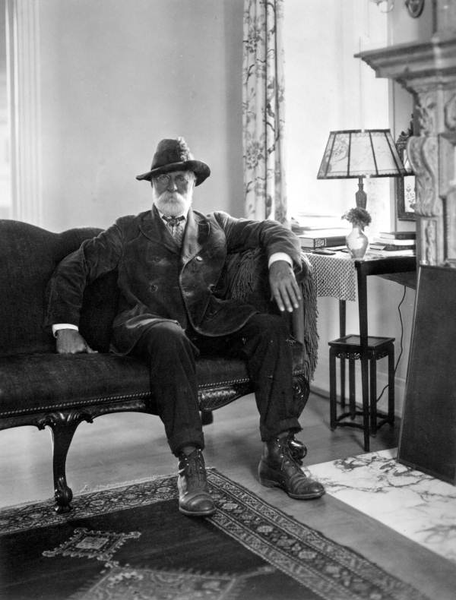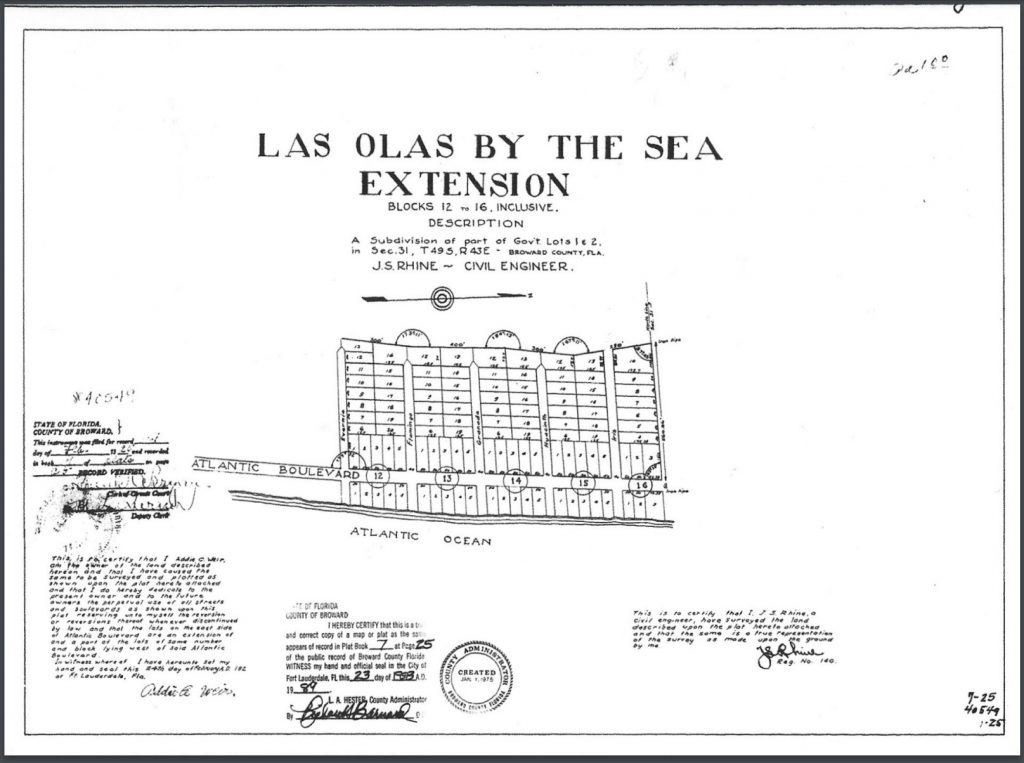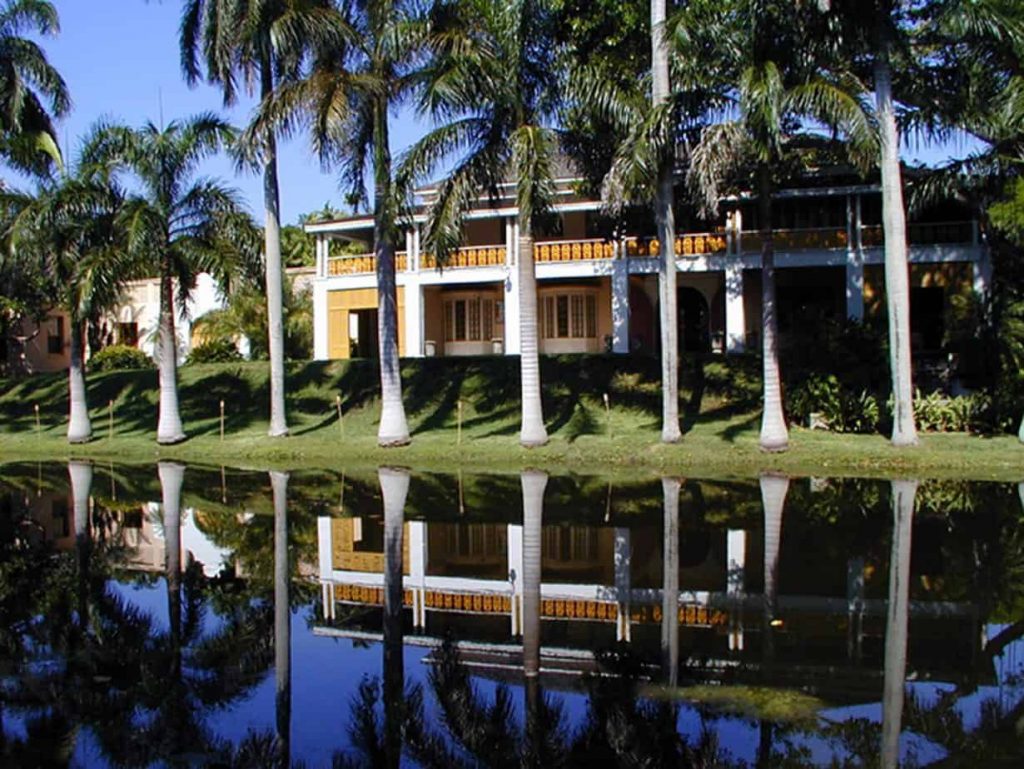About
Birch Park Beach HOA Overview
Birch Park Birch HOA is a unique community of strictly single-family homes along the west side of A1A on nine side streets. We celebrated our 100-year anniversary in 2025.
Known on maps as the Birch Park Finger Streets, the legal description describes the neighborhood as Las Olas By The Sea Extension. This neighborhood was developed by Hugh Taylor Birch in 1923-1925 from his adjacent private property. Our western border is Hugh Taylor Birch State Park.
The southern half of the neighborhood was recorded as a development on October 24, 1923. There were 84 lots in this first phase. Sixteen months later on February 24, 1925, the northern streets were added with 87 additional lots established. As the properties were sold, some buyers bought multiple lots or split additional lots. There were 171 lots, but the current number of taxed parcels is 150 properties, 10 of which are currently vacant lots.
Aerial view of our 100 year old community
Birch Park Beach HOA History



Our neighborhood was developed by Hugh Taylor Birch, a Chicago attorney who came to south Florida in 1893 in search of a secluded area to build a home. Ultimately, he chose a small village in Fort Lauderdale which included a few homes, old army posts, and a store. He purchased 3.5 miles of oceanfront property which extended to inland areas bordered by Federal Highway, US Hwy 1. As he developed various areas he kept 180 acres as his private estate, now known as Hugh Taylor Birch State Park.
Mr. Birch was born August 2, 1848, in Newport Township, Illinois. He died at the age of 94 on January 7, 1943. During his lifetime the world changed very dramatically. He was a teenager during the Civil War, lived through the 1st World War and saw the start of the 2nd World War. Invention of the automobile and airplanes were significant changes from his boyhood to the end of his life. His wife Maria died in 1913. They had three children: Carlton who died at age 5 in 1882, Hugh Jr. who died at age 19 in 1907, and Helen who died in 1925 at age of 42. He outlived his wife and all three children, and never had any grandchildren.
Hugh Taylor Birch worked as an attorney for John D Rockefeller’s Standard Oil Company. When he bought the land in 1893, it was considered unsuitable for most people. The sandy soil could not be farmed, storms were eroding land, and there was very little fresh water. First recorded human visitors were the early Tequesta Indians who did not stay in the area for long. The first people to live on the barrier island were army soldiers who came to the area in 1839 to establish a second “fort” during the 2nd Seminole War. Mr. Birch and a business partner bought over 3000 acres for $3500 in 1893. In 1902 they divided the parcel with Mr. Birch taking the land north of Las Olas Blvd. He built a small cottage on what is now Granada Street on the southern edge of his vast property. Mr. Birch sold and donated most of his land in the boom after the World War I during the Roaring 20’s. He developed the Las Olas by the Sea Extension, later known as the Birch Park Finger Streets, from the autumn of 1923 through the spring of 1925.
He donated the right of way to create Sunrise Boulevard through his property. He ceded land for Highway A1A and gave the beach he owned to the city.
After his son-in-law remarried, he decided to move out of Bonnet House and built himself a house on A1A next to the current Welcome Center within the park in 1940. In March 1942, nine months before his death, Florida governor Spessard Holland came to visit Mr. Birch who presented the governor with a deed for 180 acres to be turned over to the State of Florida upon his death. He died there in 1943 at the age of 94. He was a visionary pioneer who knew that his property and city had changed dramatically in the 50 years since he arrived in 1893. He wanted to forever preserve a section of wild landscape for generations. We are all fortunate to Mr. Hugh Taylor Birch for our name and our ability to have a jewel of a neighbor to enjoy for years to come.
Connection to Bonnet House
In 1919, he gave the 35 acres south of our neighborhood now known as Bonnet House to his only daughter Helen as a wedding present. At age 36, Helen became the second wife of Chicago painter Frederick Clay Bartlett. They started construction of the Bonnet House in 1920. Mr. Birch lived there 20 years until 1940 when he built his home on A1A within the State Park. Helen died of breast cancer in 1925, only two years after the home was completed. She had no children. She was one of the first Americans to collect Post-Impressionist works and had a collection of paintings by Cezanne, Picasso, van Gogh, Matisse and Seurat. Upon her death many of these works were donated to the Art Institute of Chicago. Mr. Bartlett seldom visited during the next six years as Mr. Birch primarily occupied the home.
In 1931, Mr. Bartlett married his third wife Evelyn Fortune Lilly, another heiress. She was the daughter of the Fortune family from Indianapolis and was the ex-wife of Eli Lilly, founder of the pharmaceutical company. After Mr. Bartlett died in 1953, she continued to use the home as her winter residence. She then married Daniel Huger but later divorced him in 1969. Evelyn Fortune Bartlett also did not have any children, so in 1983 she gave the Bonnet House to the Florida Trust for Historic Preservation. She lived to be an astounding 109 years old and died in 1997 at her home in Beverly, Massachusetts. Thank you to Mrs. Evelyn Fortune Bartlett for her vision and donation which preserved another piece of local history. Be sure to visit Bonnet House Museum & Gardens.

